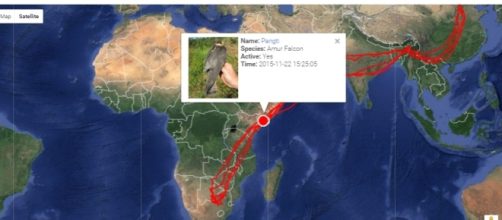Falco project EU run a brilliant raptor migration program. Partnered with the Wildlife Institute of India, Birdlife Hungary others, they track the flight of these birds across oceans.
One of the most impressive raptors that they track is the Amur Falcon. The Amur Falcon is a small raptor and weighs only about 150 to 200 grams. The birds travel all the way from high up in Eastern Asia to Africa every year. Ali & Ripley (1987) and Naoroji (2007) both noted that the birds fly across China to India and Bangladesh in the first stage of their massive flight across the ocean to Africa.
The route these little raptors take across the ocean is the longest migration over vast expanses of the sea, of any bird of prey. Their journey is over 4000 km.
They undertake the longest regular over-water migration of any bird of prey, crossing over the Indian Ocean between western India and tropical east Africa, a journey of more than 4,000 km.
Conservation India reported in October 2012, that massive numbers of these migratory birds were killed for food in Nagaland, a North Eastern Indian state. Back in 2012, researchers believed that up to 140,000 individuals had been killed for human consumption, and this was the estimate from only one known site.
Alarmed, India was very quick to pass a ban on hunting of these birds.
This was followed by extensive education programs.
On November 6, 2013, three birds were captured, ringed and had solar powered tracking units attached. The Amur Falcon Partnership now satellite track the incredible journeys that some of the birds undertake every year.
Bird lovers can easily find and follow the fascinating travels across the ocean by visiting the Amur Falcon Partnership website. At the top right of the landing page, visitors can choose their language. The routes of all the tagged birds can be followed by a simple filter system by visiting the satellite-tracking page. By clicking on the BIRDS tab at the top menu, a new page will open. The page has literally hundreds of different birds that can be filtered by active, inactive, country and species.
The birds are listed in alphabetical order by their allocated names. If as I did, you choose to look at Pangti the Amur Falcon from India, you can tick the box next toPangti’s name, then return to the top of the page and click on the Send to Map Tab. Next,Press Play and an animated flashing light shows the flight progress.
This will bring up the flight routes of Pangti over the years 2013 until 23 November 2015 when the bird arrived safely in Africa. Seen by satellite, the distance of the flight is very impressive. Pangti reached Somalia over the weekend and another bird, Naga arrived in Kenya.
Bird lovers were able to cheer their birds on; holding thumbs all the way, that they would arrive safely.
If you missed their flight into Africa, around April 2016, you will be able to watch their progress via the maps as they return to East Asia.
You can choose to watch other birds that are active and moving around in real time by using the filters available. There is plenty of information about the various projects and sponsors for those who wish to find out more.
The wonderful facility to engage with the migratory birds is a boon to bird lovers worldwide. The site is full of information about the many species that migrate. Viewers can choose from Peregrine falcons, Marsh harriers, Imperial Eagles, Black storks and more.
Right now, you can track Csele, a European roller who left Hungary on 9 September and has reached central Zambia on 24 November this year.
Go and have fun. This is simply one of the best sites for bird lovers on the net.
RHINO LOVERS ACROSS THE WORLD MOURN THE LOSS OF NOLA AND SHARE THE PAIN OF SAN DIEGO ZOO
FIVE HIGH PROFILE CONSERVATIONISTS WHO WERE MURDERED TRYING TO PROTECT THE PLANET

